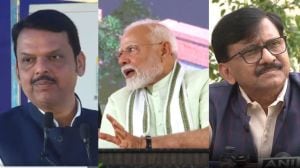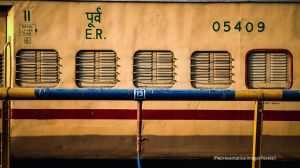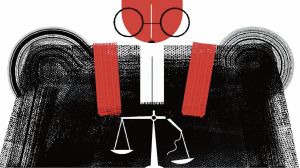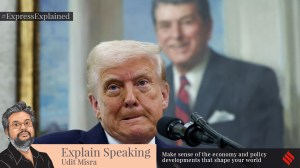UPSC Key: NJAC Act 2014, Signal and United Nations World Water Development Report 2025
Why The Kerala State Private Universities (Establishment and Regulation) Bill 2025 is relevant to the UPSC exam? What is the significance of topics such as the finance bill 2025, underutilization of pollution control funds and Aadhaar-Voter ID linking initiative on both the preliminary and main exams? You can learn more by reading the Indian Express UPSC Key for March 26, 2025.
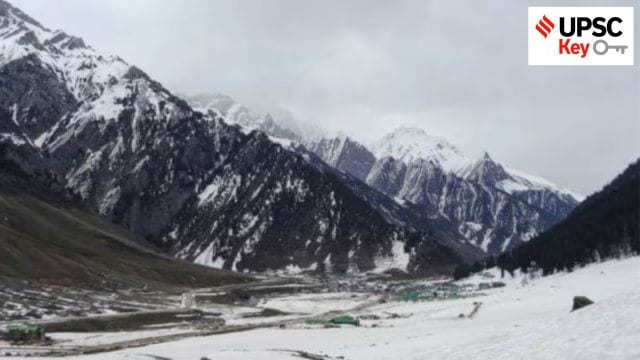 UPSC Key March 2025: Here's what you should be reading from the March 26, 2025 edition of The Indian Express
UPSC Key March 2025: Here's what you should be reading from the March 26, 2025 edition of The Indian Express Important topics and their relevance in UPSC CSE exam for March 26, 2025. If you missed the March 25, 2025 UPSC CSE exam key from the Indian Express, read it here
FRONT PAGE
‘Things would have been different’: V-P revives NJAC debate as SC panel probes
Syllabus:
Preliminary Examination: Indian Polity and Governance
Main Examination:
• General Studies II: Structure, organization and functioning of the Executive and the Judiciary
• General Studies II: Important aspects of governance, transparency and accountability,
What’s the ongoing story: Amid the row over the discovery of wads of currency notes at the New Delhi home of Justice Yashwant Varma who has since been moved out of Delhi High Court, Vice President and Rajya Sabha Chairman Jagdeep Dhankhar, referring to the National Judicial Appointments Commission Act passed by Parliament in 2014, said that “things would have been different” if the mechanism for judicial appointments had not been struck down by the Supreme Court.
Key Points to Ponder:
• National Judicial Appointments Commission (NJAC) Act 2014-Know the key highlights
• Supreme Court on NJAC Act 2014 (99th Constitutional Amendment Act)-know in detail
• Why NJAC Act 2014 was struck down by the Supreme Court in 2015?
• How did the collegium system evolve when the Constitution is silent on it?
• The National Judicial Appointments Commission Act of 2014 and the Collegium System-Compare and Contrast
• Examine the impact of judicial independence on democracy in India.
• Should there be an alternative to the collegium system for judicial appointments?
• The NJAC debate highlights the need for judicial reforms in India. Suggest measures to improve transparency and accountability in the appointment of judges.
• Do you think the executive should have a role in the appointment of judges—Critically evaluate in the context of the doctrine of separation of powers.
Key Takeaways:
• Dhankhar also held a meeting with floor leaders of parties to discuss the issue. His remarks came on the day a three-member committee constituted by the Supreme Court began its inquiry into the conduct of Justice Varma and visited his residence in the afternoon.
• The committee, comprising Chief Justice of Punjab and Haryana High Court Justice Sheel Nagu, Chief Justice of Himachal Pradesh High Court Justice G S Sandhawalia, and Justice Anu Sivaraman of Karnataka High Court, reached Justice Varma’s Tughlak Crescent bungalow at around 1.30 pm and left after nearly 45 minutes.
• On Monday, the Supreme Court Collegium formalised its recommendation for the transfer of Justice Varma to Allahabad High Court. Sources said the opinion of the judges and the response of Justice Varma were examined. Justice Varma said he was willing to go to Allahabad High Court, sources said.
• Taking serious note of the discovery of cash at the house of the High Court judge, Dhankhar had discussed the issue Monday with Leader of the House in Rajya Sabha J P Nadda and Leader of the Opposition Mallikarjun Kharge.
Do You Know:
• The Constitution (99th Amendment) Act, which established the NJAC and the NJAC Act, was passed by Parliament in 2014 to set up a commission for appointing judges, replacing the Collegium system. This would essentially increase the government’s role in the appointment of judges.
• The NJAC was to comprise the Chief Justice of India as the ex officio Chairperson, two senior-most Supreme Court Judges as ex officio members, the Union Minister of Law and Justice as ex officio member, and two eminent persons from civil society — one of whom would be nominated by a committee consisting of the CJI, Prime Minster and the Leader of Opposition in the Lok Sabha, and the other would be nominated from the SC/ST/OBC/minority communities or women. The laws were repealed in October 2015 after the Supreme Court struck them down.
• The NJAC Act had proposed that appointment of judges be done by a six-member body, headed by the Chief Justice of India, and comprising two most senior SC judges, the Union Law Minister and two “eminent” persons. The two eminent persons were to be selected by a panel comprising the Prime Minister, the CJI and the leader of the largest Opposition party in Lok Sabha.
• However, the Supreme Court was of the view that there was no question of accepting an alternative procedure which did not ensure primacy of the judiciary in the matter of selection and appointment of judges in the higher judiciary.
Other Important Articles Covering the same topic:
📍Collegium vs NJAC: What is the renewed debate over appointment of judges?
Previous year UPSC Mains Question Covering similar theme:
📍Critically examine the Supreme Court’s judgment on ‘National Judicial Appointments Commission Act, 2014’ with reference to the appointment of judges of higher judiciary in India. (UPSC CSE 2017)
EC proposal: Voters who decline to give Aadhaar need to appear, explain why
Syllabus:
Preliminary Examination: Indian Polity and Governance
Main Examination: General Studies II: Salient features of the Representation of People’s Act.
What’s the ongoing story: Going forward, a voter declining to share their Aadhaar number with the Election Commission (EC) may have to make a personal appearance before the Electoral Registration Officer (ERO) to show cause for not providing this information.
Key Points to Ponder:
• Discuss the rationale behind the Election Commission’s proposal to link Aadhaar with Voter ID. What are the potential benefits and concerns associated with this move?
• What are the constitutional and legal implications of making Aadhaar-Voter ID linking mandatory in the electoral process.
• How can the government balance the need for electoral integrity with concerns over privacy and data security in the Aadhaar-Voter ID linking initiative?
• The proposal requiring voters to justify their refusal to link Aadhaar with Voter ID raises concerns over the right to privacy and voluntary consent—Comment
• Compare India’s approach to voter identification and authentication with global best practices.
Key Takeaways:
• An ERO, typically a civil service/revenue officer, is empowered by Section 13B of the R P Act 1950 to prepare, update and revise electoral rolls (more commonly known as the “voters’ list”) for Assembly constituencies. EROs are designated by the Election Commission in consultation with State Governments.
• Currently, the EC, up to 2023, had collected Aadhaar details of over 66 crore voters, who had “voluntarily” offered this information. But the two databases for these 66 crore voters haven’t been linked. In other words, so far, Aadhaar hasn’t been used to weed out duplicate entries or enable clean-up of electoral rolls.
• The proposal that every voter who doesn’t provide her 12-digit unique identity number needs to give an explanation in person before an ERO is understood to have been discussed at a high-level meeting last week between senior officers of the EC and representatives from the Home Ministry, Law Ministry, IT Ministry, and UIDAI, and is likely to be part of the amended Form 6B.
• With this change, the EC hopes that sharing Aadhaar number will be categorically clarified as a “voluntary” exercise and it will, consequently, fulfil its commitment before the Supreme Court (in G Niranjan Vs Election Commission of India) in September 2023.
Do You Know:
• Currently, Form 6B, which was introduced to collect Aadhaar numbers of voters, lacks options for electors to abstain from providing Aadhaar, offering only two choices: either provide Aadhaar or declare, “I am not able to furnish my Aadhaar because I don’t have Aadhaar number.”
• The latter, the petitioners in G Niranjan Vs Election Commission of India case had said, basically forced voters to give a false undertaking when they actually don’t wish to volunteer that information.
• According to the proposal discussed in the March 18 meeting, Form 6B will be tweaked to remove the latter declaration (“I am not able to furnish my Aadhaar because I don’t have Aadhaar number”). It will now have just one declaration that the voter is providing an alternative document (out of the predetermined list of documents mentioned in Form 6B) and will appear before ERO on a given date to explain why she is not sharing Aadhaar details.
• This change will have to be notified by the Law Ministry by way of the gazette notification only after EC sends a formal proposal to the Union government on the same. This amendment is likely to happen before the next set of Assembly elections in Bihar.
Other Important Articles Covering the same topic:
Previous year UPSC Prelims Question Covering Similar Theme:
1. Consider the following statements: (2018)
1. Aadhaar card can be used as a proof of citizenship or domicile.
2. Once issued, Aadhaar number cannot be deactivated or omitted by the Issuing Authority.
Which of the statements given above is/are correct?
(a) 1 only
(b) 2 only
(c) Both 1 and 2
(d) Neither 1 nor 2
IN PARLIAMENT
Syllabus:
Preliminary Examination: General issues on Environmental ecology, Bio-diversity and Climate Change – that do not require subject specialization.
Main Examination:
• General Studies II: Government policies and interventions for development in various sectors and issues arising out of their design and implementation.
• General Studies III: Conservation, environmental pollution and degradation, environmental impact assessment.
What’s the ongoing story: Less than 1 per cent of the Rs 858 crore allocated to the Ministry of Environment, Forest and Climate Change for the ‘Control of Pollution’ scheme in the financial year 2024-25 has been utilised so far, according to a report tabled in Parliament.
Key Points to Ponder:
• ‘The underutilization of pollution control funds by the Environment Ministry has raised concerns over India’s commitment to environmental protection’—discuss
• What are the reasons for underutilization of pollution control funds?
• What are the challenges in implementing pollution control policies effectively?
• “India’s commitment to environmental protection—What are the major policies and schemes in place?”
• Know the role of financial allocations and institutional efficiency is crucial in tackling environmental degradation.
• How better governance and accountability can ensure effective pollution control in India?
• Despite having comprehensive environmental laws, India struggles with air pollution and waste management—Why?
• Discuss the role of parliamentary committees in environmental governance.
Key Takeaways:
• The department-related standing committee on science and technology, environment, forests and climate change expressed its shock in the Demands for Grants (2025-26) report and asked the ministry to “introspect” and take serious note of the reasons for the gross underutilisation.
• In response to the panel’s surprise over the expenditure of only Rs 7.22 crore until January 21 out of the revised allocation of Rs 858 crore, ministry officials stated that funds could not be utilised as approval for the scheme’s continuation was awaited. Over the past two financial years, the ministry spent all of the budget allocated for the scheme, the report showed.
• “…the committee is shocked to note that amount to the tune of Rs 858 crore allocated for ‘Control of Pollution’, which is 27.44 percent of the annual RE (revised estimate) allocation of the ministry, remains unutilized since the approval for continuation of Control of Pollution Scheme till 2025-26 is, awaited, even at the far end of the financial year,” the House panel stated in its report.
• As part of parliamentary oversight, department-related standing committees scrutinise spending and performance of government ministries as against budgetary allocations and present reports to the Parliament.
Do You Know:
• The Centre fully funds the scheme and it is one of the key sources of the Centre’s flagship National Clean Air Programme (NCAP), which has set targets to reduce particulate matter 10 (fine pollutants) pollution in 131 cities across the country by 2026. The 15th Finance Commission funds NCAP for 49 cities with over a million people, and the ‘Control of Pollution’ scheme funds plans to clean dirty air in 82 ‘non-attainment’ cities which do not conform to air quality standards.
• The ‘Control of Pollution’ scheme was launched in 2018 to monitor air, water and noise pollution and their quality levels across the country. It consists of components such as funding assistance to weaker state pollution control boards to control pollution, and an environmental monitoring network programme to carry out pollution monitoring. Just weeks ago, the World Air Quality Report 2024 said Delhi was the world’s most polluted capital, with an average PM2.5 concentration of 91.8 micrograms/cubic metre, and 13 of the 20 most polluted cities of the world were in India.
• On climate change issues, the House panel expressed concern over the US administration’s withdrawal from global climate efforts and climate funding. It said that India, being a large country, must take big responsibility.
Other Important Articles Covering the same topic:
📍Why the Union Budget needs to provide more for energy efficiency measures
Previous year UPSC Prelims Question Covering Similar Theme:
2. In the cities of our country, which among the following atmospheric gases are normally considered in calculating the value of Air Quality Index? (2016)
1. Carbon dioxide
2. Carbon monoxide
3. Nitrogen dioxide
4. Sulphur dioxide
5. Methane
Select the correct answer using the code given below:
(a) 1, 2 and 3 only
(b) 2, 3 and 4 only
(c) 1, 4 and 5 only
(d) 1, 2, 3, 4 and 5
Digital record will help track unaccounted money: FM
Syllabus:
Preliminary Examination: Indian Polity and Governance-Constitution, Political System, Panchayati Raj, Public Policy, Rights Issues, etc.
Mains Examination: General Studies II: Parliament and State legislatures—structure, functioning, conduct of business, powers & privileges and issues arising out of these.
What’s the ongoing story: The new Income Tax Bill will be taken up for discussion in the Monsoon Session of Parliament, Finance Minister Nirmala Sitharaman said on Tuesday.
Key Points to Ponder:
• What is the finance bill 2025?
•The government has proposed to strengthen legal provisions to track digital assets under the new Income Tax Bill, 2025-know in detail
• Discuss the significance of incorporating digital records into the Income Tax Act as highlighted by Finance Minister Nirmala Sitharaman.
• Discuss the implications of the removal of the 6% Equalization Levy on digital advertisements as proposed in the Finance Bill, 2025. How might this affect India’s trade relations with the United States?
• The Finance Bill, 2025, proposes the introduction of a new Income Tax Bill to replace the Income Tax Act of 1961. Critically assess the need for this change and its potential impact on tax compliance and administration.
• Article 110, Article 117 (1) and Article 117 (3)-Compare and Contrast
• How finance bill becomes act?
• What happens after Rajya Sabha returns Finance Bill with or without amendments?
• The Rajya Sabha should return the Finance bill to the Lok Sabha within fourteen days-True or false?
• There is a key difference between a money Bill and Finance bill—what is that?
Key Takeaways:
• Replying to the discussions on the Finance Bill, 2025 in the Lok Sabha, Sitharaman said the new I-T Bill, which was introduced in the House on February 13, is currently being vetted by the Select Committee.
• The committee has been mandated to submit its report by the first day of the next session of Parliament, said the minister. “…we will take it (new Income Tax Bill) up in the monsoon session,” Sitharaman said. She said the digital record will also be taken into account for the assessment once the new I-T Bill is passed.
• On the Opposition’s concern that certain provisions in the new I-T Bill breach taxpayers’ privacy, the Finance Minister said scanning Google map history, WhatsApp chats and Instagram accounts has helped the government track unaccounted money.
• The new Bill gives tax officers powers to override the access code of computer systems and virtual digital space, including online trading and investment accounts as well as cloud servers, in search and seizure cases.
• Sitharaman said it was being specifically mentioned in the new Bill because the 1961 Income Tax Act permitted examination of books of account physically kept, and every manual record of the person’s income and expenditure.
• Since the 1961 Act does not mention the “digital”, most often it becomes contentious and people go to the court and seek protection from not sharing passcode, she said. “So, digital becomes an issue… That gap is getting filled up in the new Income Tax Bill which is before the select committee,” the minister said.
Do You Know:
• The Lok Sabha passed the Finance Bill 2025 on March 25, along with 35 government amendments, including one abolishing a six per cent digital tax on online advertisements. With the passage of the Finance Bill 2025, the Lok Sabha completed its part of the Budgetary approval process.
• In a general sense, any Bill that relates to revenue or expenditure is a Financial Bill. A Money Bill is a specific kind of Financial Bill, defined very precisely: a Bill is deemed to be a Money Bill if it deals only with matters specified in Article 110 (1) (a) to (g). A Money Bill is certified by the Speaker as such — in other words, only those Financial Bills that carry the Speaker’s certification are Money Bills.
• Financial Bills that are not certified by the Speaker are of two kinds: Bills that contain any of the matters specified in Article 110, but do not contain only those matters [Article 117 (1)]; and ordinary Bills that contain provisions involving expenditure from the Consolidated Fund [Article 117 (3)].
• A Bill of the first kind, like a Money Bill, can be introduced only in Lok Sabha, and only with the recommendation of the President. But other restrictions that apply to Money Bills do not apply to these Bills. Bills under Article 117 (3)can be introduced in either House, though the President’s recommendation is essential for their consideration, and therefore, passage.
• Under Article 110(1) of the Constitution, a Bill is deemed to be a Money Bill if it contains only provisions dealing with all or any of the following matters:
(a) the imposition, abolition, remission, alteration or regulation of any tax;
(b) regulation of borrowing by the government;
(c) custody of the Consolidated Fund or Contingency Fund of India, and payments into or withdrawals from these Funds;
(d) appropriation of moneys out of the Consolidated Fund of India;
(e) declaring of any expenditure to be expenditure charged on the Consolidated Fund of India or the increasing of the amount of any such expenditure;
(f) receipt of money on account of the Consolidated Fund of India or the public account of India or the custody or issue of such money or the audit of the accounts of the Union or of a State; or
(g) any matter incidental to any of the matters specified in sub-clauses (a) to (f).
Other Important Articles Covering the same topic:
📍New Income Tax Bill defines virtual digital space for searches, seizures
📍Money Bills vs Finance Bills: What are the differences, what the court has rule
Previous year UPSC Prelims Question Covering Similar Theme:
3. Regarding the Money Bill, which of the following statements is not correct? (2018)
(a) A bill shall be deemed to be a Money Bill if it contains only provisions relating to the imposition, abolition, remission, alteration or regulation of any tax.
(b) A Money Bill has provisions for the custody of the Consolidated Fund of India or the Contingency Fund of India.
(c) A Money Bill is concerned with the appropriation of money out of the Contingency Fund of India.
(d) A Money Bill deals with the regulation of borrowing of money or giving of any guarantee by the Government of India.
THE EDITORIAL PAGE
Syllabus:
Preliminary Examination: Current events of national and international importance.
Main Examination: General Studies II: Bilateral, regional and global groupings and agreements involving India and/or affecting India’s interests.
What’s the ongoing story: C Raja Mohan writes: Even as Europe struggles to lend military support to Ukraine after Trump’s decision to pull back, it is also debating several longer-term strategies – from conscription to nuclear weapons — to cope with Russian security challenges on its own.
Key Points to Ponder:
• Analyze the impact of a potential decline in U.S. military commitment to Europe.
• How can European nations strengthen their own defense capabilities in response to emerging security challenges?
• Discuss the role of NATO in maintaining European security.
• How does the Russia-Ukraine conflict shape NATO’s strategic posture?
• The European Union has sought to develop its own strategic autonomy in defense—examine the feasibility of an independent European security framework without U.S. support.
• How do geopolitical developments, such as the Ukraine war, affect European energy security?
• Examine the steps taken by the European Union to reduce dependence on Russian energy imports.
• India has traditionally maintained a balanced foreign policy approach toward Europe, the U.S., and Russia. In the context of shifting power dynamics in Europe, how should India recalibrate its foreign policy to safeguard its strategic interests?
Key Takeaways:
C Raja Mohan writes:
• Even as Europe struggles to lend military support to Ukraine after Trump’s decision to pull back, it is also debating several longer-term strategies to cope with Russian security challenges on its own. For one, the idea of military conscription is no longer seen as outlandish. Croatia and Serbia have already introduced compulsory military service. Denmark, Finland and Sweden have had conscription of a kind for years. Others are looking at various models for conscription. Given Europe’s demographic decline and the steady diminution of its armed forces, some military service for young people may be inevitable.
• Second, since Trump’s return, Europe’s focus has been on boosting its conventional military strength to reduce its prolonged reliance on American weapons and personnel. Last week, the European Union finalised a plan called “Readiness 2030”, aimed at bolstering Europe’s
military capabilities.
• Finally, Europe has begun to debate the role of nuclear weapons in its new security strategy. Russia’s war in Ukraine has put an end to the argument that nuclear weapons do not matter for global security in the 21st century.
Do You Know:
C Raja Mohan writes:
• France, as Europe’s leading nuclear power, has been at the forefront of the new nuclear debate. President Emmanuel Macron has initiated consultations on how France’s nuclear deterrent could play a role in European security, inviting allies to participate in strategic dialogues and observe French nuclear exercises. This reflects France’s long-standing position that its vital interests “have a European dimension”, implying that its nuclear deterrent could contribute to broader European security.
• The road to a European nuclear deterrent, however, is littered with challenges. The combined nuclear arsenal of France and Britain, estimated at around 500 warheads, is significantly smaller than Russia’s arsenal of close to 6,000 warheads.
• Medvedev’s conception of Europe is by no means the only one in Russia. Moscow has oscillated between teasing Europeans away from America by talking of a “common European home” on the one hand and seeking a joint Russo-American condominium over Europe on the other. The former is represented by the idea of “Helsinki”, a reference to the 1970s Helsinki Accords that framed a common security framework for Europe. “Yalta” represents the latter, where Joseph Stalin, Franklin Roosevelt and Winston Churchill carved up Europe into spheres of influence at the end of World War II.
• Russia will bet that Europe, without American backing, will revert to its historical pattern of internal squabbling. The backers of the integration project hope that the old continent will finally end its geopolitical holiday. Some economists suggest that militarisation could be the answer to Europe’s prolonged economic stagnation. Optimists will argue that even the weakest entities fight back when pushed to the wall. Pessimists will keep their fingers crossed. Realists will keep Europe at the top of their geopolitical watchlist.
Other Important Articles Covering the same topic:
📍C Raja Mohan writes: Following Trump, a push to Make Europe Great Again
EXPLAINED
How global warming is affecting mountain regions across the world
Syllabus:
Preliminary Examination: General issues on Environmental ecology, Bio-diversity and Climate Change – that do not require subject specialization.
Main Examination: General Studies III: Conservation, environmental pollution and degradation, environmental impact assessment.
What’s the ongoing story: Soaring temperatures are leading to rapid and largely irreversible changes in the mountain ranges of the world, according to a new UNESCO report. In several regions, higher elevations seem to be warming faster than lower ones; glaciers are melting at an accelerated rate; permafrost is thawing at an increased rate; snow cover has declined; and snowfall patterns have become more erratic.
Key Points to Ponder:
• ‘The United Nations World Water Development Report 2025 – Mountains and glaciers: Water towers’—know its key highlights
• Discuss the impact of global warming on the world’s mountain ecosystems, with a special focus on glacier retreat and water security.
• How does climate change influence the frequency and intensity of natural disasters such as landslides, avalanches, and glacial lake outburst floods (GLOFs) in mountain regions?
• The Hindu Kush-Himalayan region plays a crucial role in South Asia’s water security—Know the potential risks posed by global warming to this region and discuss adaptive measures.
• Explain how global warming is affecting biodiversity in mountain ecosystems.
• What measures can be taken to ensure the resilience of flora and fauna in mountain ecosystems?
• India has several mountain ranges that are highly vulnerable to climate change—examine the policy framework in place for the conservation of mountain ecosystems.
Key Takeaways:
• Glaciers are disappearing faster than ever, with the last three-year period seeing the largest glacial mass loss on record. Scientists measure the state of a glacier by measuring how much snow falls on it and how much melt occurs every year, according to the World Glacier Monitoring Service (WGMS).
• Since 1975, glaciers, which do not include the Greenland and Antarctica ice sheets, have lost more than 9,000 billion tonnes of mass. “This is equivalent to a huge ice block of the size of
Germany with a thickness of 25 metres,” Michael Zemp, director of the Switzerland-based World Glacier Monitoring Service, said during a press conference on Friday.
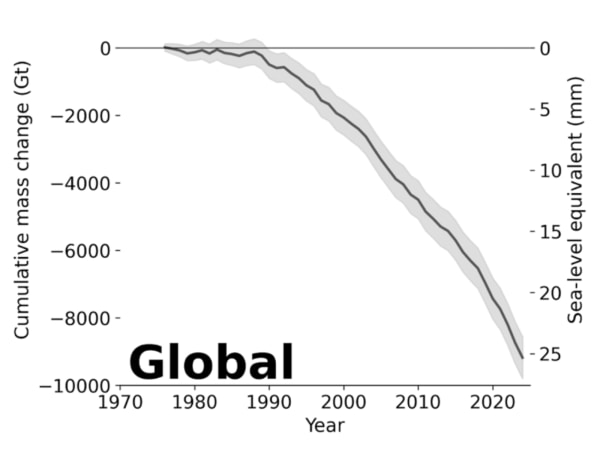 Cumulative global glacier mass changes since 1975. The graph shows the sum of annual mass changes relative to 1975. Data source: WGMS
Cumulative global glacier mass changes since 1975. The graph shows the sum of annual mass changes relative to 1975. Data source: WGMS
• He also noted that five of the last six years registered the largest losses, with glaciers losing 450 gigatons of mass in 2024 alone. Last year, glaciers in Scandinavia, the Norwegian archipelago of Svalbard and North Asia witnessed the largest annual loss of overall mass on record.
• Warmer temperatures are not the only reason behind accelerating glacier melting. More frequent and intense wildfires and dust storms are leading to more deposition of black carbon and other particulate matter on glacier surfaces and perennial snowpacks.
• “The impurities darken snow and ice surfaces, thus causing greater absorption of solar radiation… This can significantly influence the surface energy balance, thereby increasing melt rates, especially during periods and at locations of high incoming solar radiation,” according to the UNESCO report.
Do You Know:
• Permafrost is any ground that stays frozen — 0 degrees Celsius or lower — for at least two years straight. In high-altitude regions, permafrost can underlie much of the landscape. However, rising temperatures are melting permafrost in these regions rapidly. This is an issue as permafrost contains a vast amount of organic carbon and other nutrients. Mountain soils with permafrost contain approximately 4.5% of the global soil organic carbon, according to the UNESCO report. As the permafrost thaws, this organic carbon is released into the atmosphere, exacerbating climate change.
• According to the UNESCO report, snow cover in nearly all mountain regions has reduced, especially in spring and summer, with an expected further decrease in the coming decades. Snow cover is the total of all the snow and ice on the ground. It includes new snow and previous snow and ice that have not melted.
• A study, ‘Uneven global retreat of persistent mountain snow cover alongside mountain warming from ERA5-land, published in the journal Nature in November 2024 revealed that there had been a significant global mean decline of 7.79% in persistent snow cover between 1979 and 2022.
• In some regions, the elevation at which rainfall transitions to snowfall is shifting upwards due to atmospheric warming, the UNESCO report says. “Lower elevations and warmer climates are therefore undergoing greater decreases in snow cover depth and duration,” the report added.
• Mountains, which cover 33 million sq km of the Earth’s surface, are crucial for sustaining life on the planet. For instance, around 2 billion people downstream depend on mountains for freshwater resources from melting glaciers. If climate change-induced glacier melting continues at the current rate, it can have catastrophic impacts on these people.
• Glacier melting and permafrost thaw also increase the risk of glacial lake outburst floods (GLOFs). GLOFs are sudden and catastrophic floods caused by the failure of natural dams, usually formed by glacial moraines or ice, which contain glacial lakes. The report noted that these floods “alone have resulted in more than 12,000 deaths in the past 200 years, and have caused severe damage to farmland, homes, bridges, roads, hydropower plants… often prompting further internal displacement”.
• According to WGMS, melted ice of glaciers accounts for 25 to 30% of the currently observed increase in global sea levels. Between 2006 and 2016, the global mass loss of glacier ice amounted to 335 billion tonnes of lost ice per year, which corresponded to an increase in sea levels of almost 1 mm per year. Every millimetre can expose up to 300,000 people to annual flooding, WGMS said.
Other Important Articles Covering the same topic:
📍Warming up to climate change: How do we know humans are causing global warming?
Previous year UPSC Prelims Question Covering Similar Theme:
4. Which of the following statements is/are correct about the deposits of ‘methane hydrate’? (2019)
1. Global warming might trigger the release of methane gas from these deposits.
2. Large deposits of ‘methane hydrate’ are found in Arctic Tundra and under the sea floor.
3. Methane in atmosphere oxidizes to carbon dioxide after a decade or two.
Select the correct answer using the code given below.
(a) 1 and 2 only
(b) 2 and 3 only
(c) 1 and 3 only
(d) 1, 2 and 3
Previous year UPSC Main Question Covering Similar Theme:
📍‘Climate change’ is a global problem. How India will be affected by climate change? How Himalayan and coastal states of India will be affected by climate change? (2017)
HOW SECURE IS SIGNAL, APP TRUMP TEAM USED TO SHARE WAR PLANS?
Syllabus:
Preliminary Examination: General Science.
Main Examination: General Studies III: Awareness in the fields of IT, Space, Computers, robotics, nano-technology, biotechnology and issues relating to intellectual property rights.
What’s the ongoing story: Top Trump administration officials used the messaging app Signal to share war plans and accidentally included The Atlantic magazine’s Editor-in-Chief Jeffrey Goldberg in the encrypted group chat. Goldberg published a first-hand account on Monday detailing a discussion that happened over the app, hours before strikes on Iran-backed Houthi rebels in Yemen ordered by President Donald Trump.
Key Points to Ponder:
• What is Signal?
• Can Signal be hacked?
• Who uses Signal in the US government?
• Discuss the implications of using third-party encrypted messaging applications like Signal for governmental communications.
• Know the role of end-to-end encryption in protecting user privacy. How does Signal implement this feature, and what are its limitations?
• Evaluate the ethical and legal considerations of government officials using applications with disappearing messages for official communications.
• Examine the balance between privacy and national security in the context of encrypted messaging apps.
Key Takeaways:
• Signal is an app that can be used for direct messaging, group chats, and phone and video calls. As the app uses end-to-end encryption for its messaging and calling services, a third party cannot view conversation content or listen in on calls. “In other words, messages and calls sent on Signal are scrambled and only the sender and recipient at each end will have the key to decipher them,” according to an explainer by The Associated Press.
• Signal also does minimal data collection and includes a feature that allows for automated message deletion within a certain time frame, adding another layer of data protection. Moreover, Signal’s encryption protocol is open source, meaning experts can verify how it works and ensure it remains safe.
• According to experts, Signal is much more secure than conventional texting. However, the app can still be hacked. For instance, in February, Mandiant, a Google-owned security firm, reported that Russian-linked spies tried to hack into the Signal accounts of Ukrainian military officials by posing as trusted Signal contacts.
• Jacob Williams, a former hacker at the US National Security Agency (NSA), told Politico that one of the biggest risks of using Signal is where the data can be stored.
Do You Know:
• Signal has gained popularity in recent months in Washington, particularly after it was revealed last December that Chinese state-sponsored hackers had infiltrated US telecommunications networks and stolen a large cache of Americans’ cell phone records. The hackers
had also allegedly spied on the conversations of senior US political leaders, including Trump and Vice President J D Vance.
• According to a recent review by The AP, state, local and federal officials in nearly every US state have accounts on encrypted messaging apps such as Signal. The review also found that “many of those accounts were registered to government cell phone numbers. Some were also registered to personal numbers.”
Other Important Articles Covering the same topic:
📍‘The Atlantic’ journalist added to US govt group chat on attacking Yemen: What to know
UPSC Prelims Practice Question Covering Similar Theme:
5. Which of the following best describes the primary security feature of the Signal app?
(a) Cloud-based message storage
(b) End-to-end encryption
(c) Two-factor authentication
(d) Biometric login
Why Kerala has finally opened the door for private universities in the state
Syllabus:
Preliminary Examination: Economic and Social Development
Main Examination: General Studies II: Issues relating to development and management of Social Sector/Services relating to Health, Education, Human Resources.
What’s the ongoing story: The Kerala assembly Tuesday (March 25) passed a draft bill that will now allow entry to private universities in the state.
Key Points to Ponder:
• The Kerala State Private Universities (Establishment and Regulation) Bill, 2025-know its key provisions
• How does it compare with legislation in other states?
• What prompted the state’s decision to allow private universities?
• How has the Left changed its stance on private institutions in Kerala?
Key Takeaways:
• The Kerala State Private Universities (Establishment and Regulation) Bill, 2025, was passed after two days of legislative deliberation. It was presented in the assembly earlier this month and referred to a subject committee for review.
• This marks a significant shift in the stance of the Left which has historically opposed private involvement in education in the state. Currently, Kerala is the only state without private universities.
Do You Know:
• The Kerala State Private Universities (Establishment and Regulation) Bill provides for government representatives or nominees in all three key decision-making bodies of private universities – the governing, executive and academic councils.
• The university’s governing council will control its functioning and make its statutes. According to the bill, it will have three
government representatives out of its 12 members – the Secretary of the Higher Education Department, another Secretary, and an eminent academician nominated by the government. Four of the remaining members will be nominated by the sponsoring body that sets up the university.
Other Important Articles Covering the same topic:
📍CPM’s big U-turn: Kerala moves to allow private universities, ‘have to absorb changes to survive’
|
PRELIMS ANSWER KEY |
|
1. (d) 2.(b) 3.(c) 4.(d) 5.(b) |
For any queries and feedback, contact priya.shukla@indianexpress.com
Subscribe to our UPSC newsletter. Stay updated with the latest UPSC articles by joining our Telegram channel – IndianExpress UPSC Hub, and follow us on Instagram and X.
Must Read


Buzzing Now


Mar 31: Latest News
- 01
- 02
- 03
- 04
- 05




